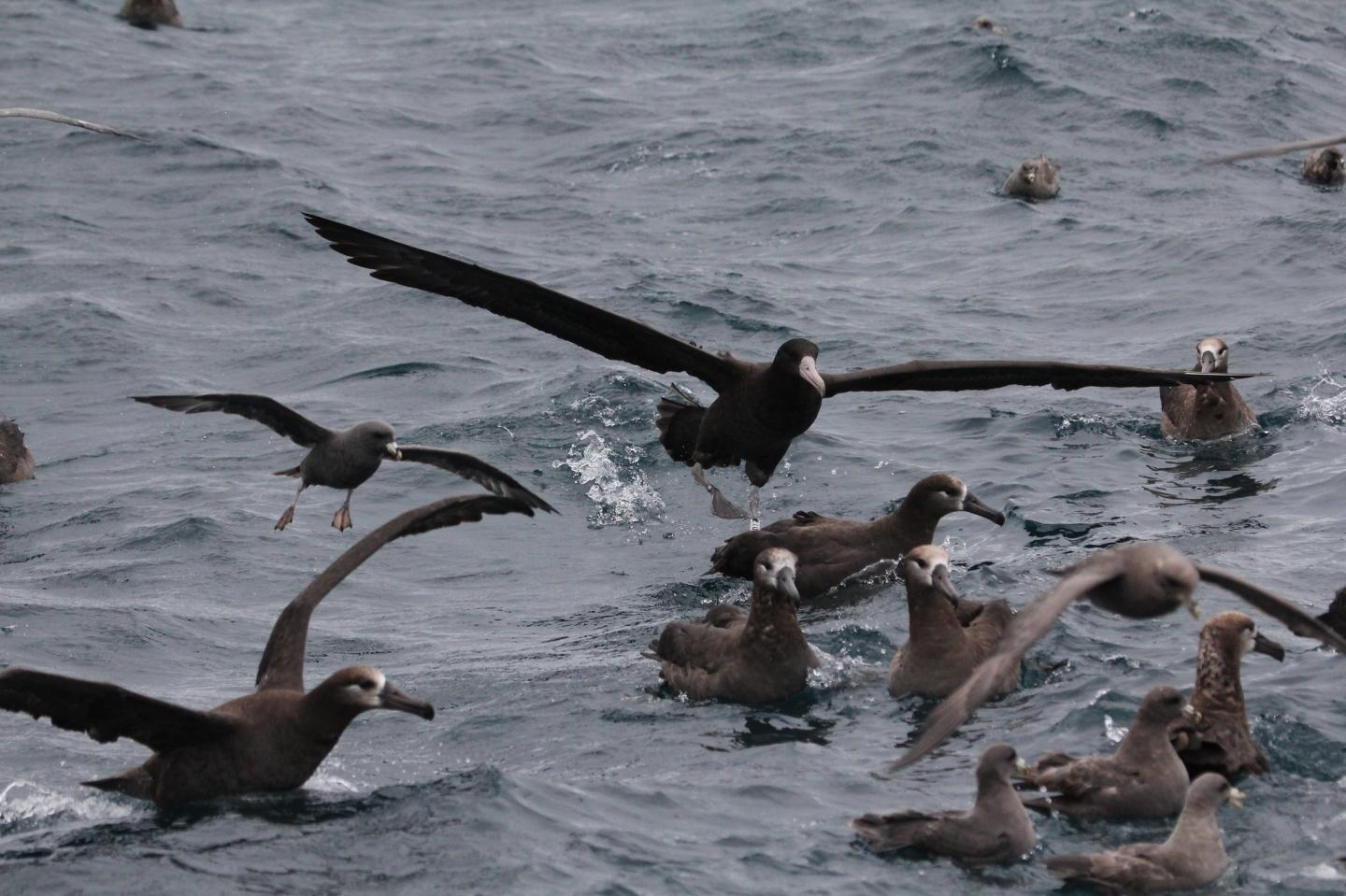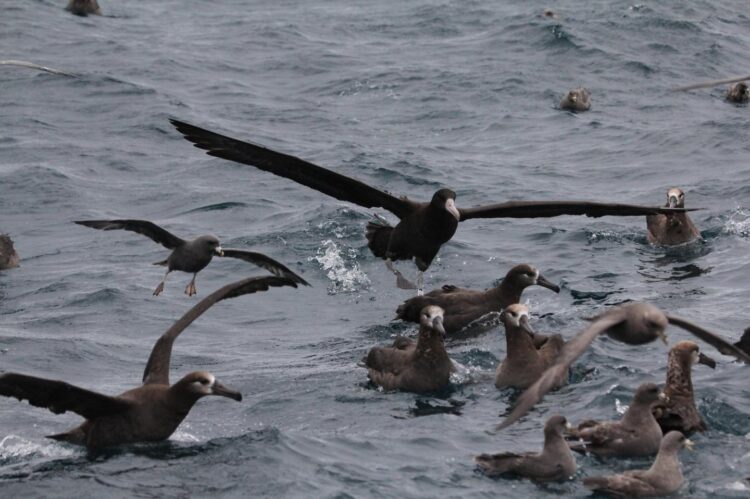
Credit: Robert Suryan.
CORVALLIS, Ore. – A novel analysis of encounters between albatross and commercial fishing vessels across the North Pacific Ocean is giving researchers important new understanding about seabird-vessel interactions that could help reduce harmful encounters.
The new research method, which combines location data from GPS-tagged albatross and commercial fishing vessels, allows researchers to accurately identify bird-vessel encounters and better understand bird behavior, environmental conditions and the characteristics that influence these encounters.
“It is hard to conceptualize how often birds encounter vessels in the open ocean, but with this new data, it becomes really apparent,” said Rachael Orben, an assistant professor in the Department of Fisheries and Wildlife in Oregon State University’s College of Agricultural Sciences and the study’s lead author. “Some of these birds are in an environment where they see vessels all the time, while others are in an environment where they rarely encounter vessels.”
The findings were just published in the Journal of Applied Ecology. Co-authors include Leigh Torres, an associate professor at OSU’s Marine Mammal Institute, and David Kroodsma, director of research and innovation for Global Fishing Watch, a not-for-profit organization dedicated to advancing ocean governance through increased transparency of human activity at sea.
Albatross are large, long-lived seabirds that roam widely over the open ocean. Three albatross species are found in the North Pacific: the black-footed albatross, the Laysan albatross and the short-tailed albatross. All three species are of high conservation concern and the short-tailed albatross is listed as endangered under the Endangered Species Act.
Fishing activity can offer the birds opportunities for foraging, but not without risks, including threat of bycatch. Bycatch is the term for fish, birds or other animals caught unintentionally and includes interactions with fishing vessels and fishing gear.
Researchers have been using biologging, the practice of attaching data recording devices to animals, to track individual bird movements at sea for more than 20 years. But they have not had much access to information about the location of vessels, which is a critical piece to understanding the seabird-fishery interaction puzzle, Torres said.
Torres learned that Global Fishing Watch was processing and making available data from the Automatic Identification System, or AIS, an automatic tracking system that uses transceivers on ships. The data includes information about vessel size, movement, fishing method and more. Access to the data was a “game-changer,” she said.
“With their data, you can track individual vessels,” Torres said. “You can get precise information about a vessel’s location, its size, the type of fishing gear it is using and the flag nation of the ship.”
Global Fishing Watch’s goals include making commercial fishing on the high seas more transparent to the public, improving fisheries regulation and ensuring sustainability of ocean resources.
“This study represents a new frontier in our ability to understand how fisheries impact marine life,” said David Kroodsma, director of research and innovation at Global Fishing Watch. “Vessel tracking data, collected by satellites and processed with machine learning, can be a powerful tool to analyze how biodiversity and fishing vessels interact at sea.”
Members of the research team had previously collected albatross tracking data from adult black-footed albatross and Laysan albatross breeding in the Papahānaumokuākea Marine National Monument in the Northwest Hawaiian Islands; Laysan albatross nesting on Oahu, Hawaii; and juvenile short-tailed albatross originating from their colonies in Japan.
The researchers were able to marry data on fishing vessels with tracking data from the GPS-tagged albatross during the same periods to identify and locate where bird-vessel interactions occur throughout the North Pacific Ocean.
When birds are within 30 kilometers of a vessel, the researchers assumed the albatross was aware of the vessel’s presence, Orben said. When the bird was within 3 kilometers of the vessel, researchers assumed a close encounter between the two. The research team then modeled the drivers of these close encounters.
“With these models, we can start to understand why birds sometimes do and sometimes don’t interact with a fishing vessel,” Torres said. “This information can help identify how and when efforts should be made to make sure these interactions don’t go wrong for the bird. As we start to identify patterns, we can potentially help mitigate these bycatch events.”
Among the researchers’ findings:
- When birds are in a transit state – where they are traveling directly from one location to another – they are not likely to stop and engage with a vessel. But when they are in a foraging state, they are more likely to stop.
- Vessel characteristics, including fishing method and the nation of flag on the vessel did not seem to be factors in whether a bird interacted with a vessel.
- In areas where there is a lot of fishing, short-tailed and Laysan albatross associated with fishing vessels more frequently.
- Short-tailed albatross were more likely to stay with a vessel for a longer period of time in lighter wind conditions.
“These results indicate that it may be more important to use bycatch mitigation methods from a fishing vessel in low wind conditions,” Torres said. “Things like that can help guide efforts to reduce bycatch of seabirds. The best regulations are those that are the least burdensome to fishermen and the most effective.”
The analysis framework developed by the researchers could be used to study encounters between fishing vessels and other seabirds or marine mammals. Information gathered through the study of these interactions could help inform fisheries management decisions, as well, the researchers said.
“Our study is really one of the first to look at the fine-scale overlap between fishing vessels and marine animals on the high seas, in international waters,” Torres said. “It opens a whole new understanding of the dynamics between animals and vessels. This work can help the fishing community fish better and help these seabirds survive and thrive.”
###
The research team included albatross researchers from the U.S. Geological Survey, Oikonos Ecosystem Knowledge, San Jose State University, NOAA Fisheries, Yamashina Institute for Ornithology, Pacific Rim Conservation, San Diego State University and Stony Brook University.
Media Contact
Rachael Orben
[email protected]
Original Source
https:/
Related Journal Article
http://dx.





